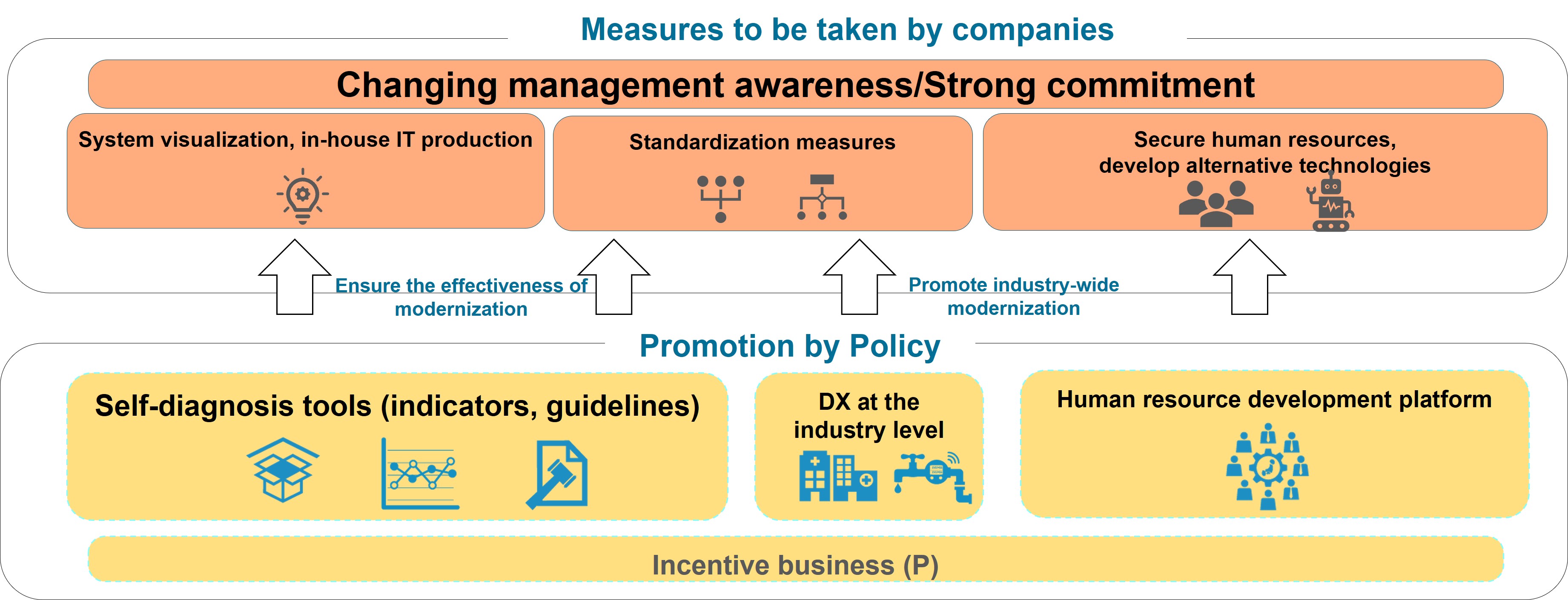- Home
- News Releases
- Back Issues
- May FY2025
- Comprehensive Report Compiled by the Legacy Systems Modernization Committee to Eliminate Legacy Systems
Comprehensive Report Compiled by the Legacy Systems Modernization Committee to Eliminate Legacy Systems
May 28, 2025
The Ministry of Economy, Trade and Industry has compiled a report on issues related to DX and legacy systems and the direction of response measures based on discussions (July 2024 - March 2025) in the Legacy System Modernization Committee* included in the Priority Plan for the Realization of a Digital Society (the Cabinet decision on June 21, 2024).
* When the Priority Plan was formulated, it was described as the Council for Elimination of Legacy Systems and System Modernization (tentative name), but it was later established as the Legacy Systems Modernization Committee with METI, the Digital Agency, and the Information-technology Promotion Agency (IPA) as the secretariat.
1. Background
In FY2024, METI established the Legacy Systems Modernization Committee as part of the Priority Plan for the Realization of a Digital Society. The purpose of the committee is to understand the current status of legacy systems, which are an obstacle to DX promotion at Japanese companies as we approach the 2025 Digital Cliff*, to clarify the problems associated with legacy systems, and to study measures to resolve these problems.
Based on the knowledge gained through the activities of the committee and the analysis results of market trend surveys, METI has organized as recommendations specific measures that are needed in order to shift to a flexible and modern system that can keep pace with business changes for corporate management, information system departments, vendor companies, and industry associations. This was compiled as a report in conjunction with the policy initiatives of the government.
2. Outline of the Comprehensive Report
1. Current status and challenges surrounding DX and legacy systems
Focusing on the obstacles Japanese companies face in promoting DX, particularly the current situation where legacy systems are holding back the introduction of the latest digital technologies, the report highlights specific issues faced by companies from the perspectives of user companies, vendor companies, and supply chains. The report addresses the current situation, where legacy systems are hindering the introduction of digital technologies while the evolution of digital technologies accelerates, and suggests that this situation may lead to a decline in Japan's industrial competitiveness.
2. The analysis results of market trend surveys and the direction of response measures necessary to address existing issues
Based on the analysis results of market trend surveys conducted from December 2024 to February 2025, the report organizes the necessary factors in modernizing legacy systems. Specifically, the report shows that there is a significant correlation between the status of information sharing with management and the establishment of Chief x Officers (CxO), andthe status of IT asset visibility and in-house production. The report also discusses supply chain risks associated with legacy systems and the supply-demand gap in human resources, both of which companies face. As suggestions derived from this, the report presents the following as effective in modernizing legacy systems: 1) changing management awareness and strengthening IT governance; 2) increasing autonomy of information system departments; 3) increasing collaboration between business departments; and 4) change of and cooperation with vendor companies.
3. Measures to be taken by companies
The report provides concrete measures that companies need to take to advance the modernization of their legacy systems. Specifically, user companies need to promote system visualization and in-house IT production, reevaluate the current practices while considering standardization measures, and train and secure upstream human resources. Vendor companies need to develop technologies to improve the productivity of modernization of legacy systems and support user companies in their in-house IT production. The reports strongly urges corporate management to recognize these challenges as their own and make strong commitments to promote them through a top-down approach. In cases where it is difficult for individual companies to tackle these challenges, the formation of ecosystems that cross company boundaries and DX initiatives at the industry level are effective.
4. Policy direction
As a national policy, METI will consider initiatives to support the modernization of legacy systems of companies. Specifically, METI will develop indicators, tools, and guidelines that will enable user companies to conduct visualization and self-diagnosis so that they can autonomously assess their DX maturity and the full scope of their IT assets. In addition, METI will develop a human resource development platform that promotes IT and the continuous learning and purposeful career development of digital human resources, and utilization of skills information in the labor market.

3. Future Schedule
In order to promote efforts to modernize the legacy systems of companies, we will conduct widespread dissemination and awareness-raising activities through industry associations and other organizations, while advancing the above policies.
Related Material
Related Links
- Legacy Systems Modernization Committee External Link (in Japanese)

- Release of the Survey Results Data of the 2024 Software Trends Survey and Call for Analysis Reports (in Japanese)

Division in Charge
Software and Information Service Industry Strategy Office, Commerce and Information Policy Bureau